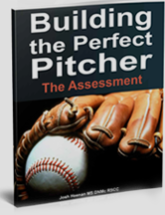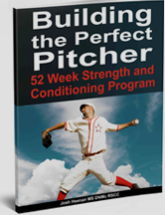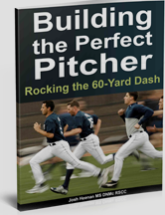The Weakest Link: Overhead Squat
I am starting this new series of blog posts called The Weakest Link. The collection of posts will focus on many aspects of training and life.
To start off The Weakest Link I am going to use the overhead squat.
The OH squat is a test of full body flexibility, mobility and strength. It is used By Physical Therapists, Athletic Trainers, Strength Coaches, and Personal Trainers as a basic evaluation tool. It is the foundation of both the Functional Movement Screen and the National Academy of Sports Medicine movement screens.
Olympic Weightlifters actually train the OH squat because when performing the snatch they must perform an OH squat to overcome the catch position.
From Top to bottom this exercise challenges elite athletes and regular training clients in a way they are not used to.
What does it actually work?
1. Wrist: Develops strength in the wrist and by maintaining a tight grip and a neutral wrist
2. Neck: Neutral position helps strengthen neck extensors that are often neglected
3. Shoulders- Pinched down and back by using the lower traps and rhomboids, this is also called packing the shoulder which is a powerful tool in creating and maintaining shoulder health. All while challenging pec and lat length.
4. Thoracic Spine (upper back vertebrae)- Mobility through extension, this is important considering that our world of computers has made everyone a hunchback these days.
Know anyone who looks like this when working on a computer?
5. Trunk- Bracing of the abdominals and stabilizing of the lower back are needed in all range of motions to prevent “dumping” the bar.
6. Hip- Strength and mobility through a full range of motion allows proper function of the hip while strengthening the musculature surrounding the joint, including the glutes.
7. Knee- Stability and strength around the knee. The quads are highly active when overcoming the bottom position of the squat.
8. Ankle- Mobility and proper movement from the ankle requires limited restrictions from the calf muscles and a full deep OH squat is impossible to perform comfortably with those restrictions.
I believe it’s easy to see how this exercise is challenging and requires many aspects of flexibility, strength, mobility, and stability.
To integrate this, I do not prescribe a load, I allow each athlete to progress as long as they are making all 3 sets of 10 reps with quality form.
My first example is a pitcher I work with whom had many limitations with this exercise when we started it 3 months ago. He had way to much neck flexion, a severe kyphotic posture, tight hamstrings, mediocre hip flexibility, and poor calf flexibility. He was nowhere near parallel to the ground with the squat, so we have kept only using the bar and worked on developing the motion and allow for the imbalances to correct themselves.
What makes him even more remarkable is that he is 6’ 9”. His progress has been a testament to the hard work he has put in, for someone whose 6’ 9” get to parallel is often a feat.
Does he have perfect form? No.
Does he have alright form for someone his size with all of his limitations? I believe so.
And although it might not seem it, his kyphosis has dramatically improved in the past few months which has actually increased his height by over an inch.
My second example is a freshman college pitcher whom had no true restrictions whatsoever. We have been able to challenge him a bit more since he is able to perform the movement proficiently. In the past 3 months he has increased his OH squat from 45 lbs for 3×10 to 135 for 3×10.
To clear up one last point, we mainly use the overhead squat as an extension of our warm-up. I am not concerned with the weight as long as form is good with every rep.
Key Coaching Points: Lock the elbows, eyes looking straight ahead, shoulders down and back, let the weight push you to the ground, and drive through the heals of your feet.
Any thoughts or comments post them below in the comments section.
It’s Not About The Weights
Strength and conditioning has a historical hard-nosed attitude towards training and change. Most strength coaches of the past have been football coaches whom have been relatively strong in the gym and thus found themselves coaching in the gym for better or worse for their athletes.
The past 4 months I was lucky enough to have an internship with Brijesh Patel, the Head Strength and Conditioning Coach at Quinnipiac University. The first day I walked in and went through one of his warm-ups and did not like how he set up one of the stretches. After speaking with B for a moment about why I did not like the execution of the stretch he tried it himself. To my surprise he agreed that my way seemed to get a better stretch than the way he used, and on the fly changed it that day while coaching his athletes. I immediately knew that internship was going to be nothing that I had expected.
B’s strength and conditioning program is more of a culture than a strength program. Every athlete is taught to be accountable for his or her actions in and out of the weight room. It is not uncommon to hear teammates yelling “watch your tempo” during the middle of lifts to ensure everyone is on pace. Trust and teambuilding is incorporated into every workout from simple things as individual warm-ups pre-workout to making sure everyone makes a given time during conditioning drills. These qualities not only build camaraderie in the weight room, but also transfer well to the playing field, where teammates must be able to rely on one another when shit hits the fan.
Demanding perfection out of every set, rep, and exercise is a prerequisite at QU. Maximal intensity is always required during ever aspect of training from cheering on teammates to post workout stretching; everything is done with a purpose. Some may think from reading this article that Brijesh is some crazy man whom expects an absurd amount from his athlete’s. Well he does, it’s expected, and excuses don’t make champions and that is his job, to develop champions. He also takes it upon himself to educate his athlete’s that this is a lifestyle, to expect the most out of themselves in all facets of life. Educating every individual on the reasoning behind why they are lifting a certain way, doing specific exercises, and why they need to fuel their bodies a specific way to get the most out of it. These are life skills that each person can take away and apply to all aspects of life.
Constant improvement is expected from B from his athlete’s and himself. If there is a way to develop stronger, faster, healthier athlete’s I can promise you it will find it’s way into a QU program. I have learned so much more over the past 4 months working with such an amazing coach, but the biggest lessons I have learned have more to do with people than anything to do with training. B is truly an innovator in the industry and just as much a life coach as a strength coach.
If I had to sum up what I’ve learned I would say “Demand hard work, strive for perfection, intensity and passion can overcome anything, and you have to have some fun”. Strength and conditioning is an essential part of every athlete’s development, but I can assure you, it’s not just about the weights.
Little Adjustments
Although I am young I have been very lucky in my career to only have one serious injury, and that was to my throwing shoulder.
Recently I have been dealing with some hip and lower back pains. Nothing to crazy just more or less nagging at my right side. I looked at my workouts and didn’t see much of a problem. I checked my footwear and found it to be correct for my feet. I moved on to my ankle and hip mobility work and saw that they were in a normal range for myself.
So what gives?
I realized after a thanksgiving induced food coma that I woke up face first, neck cramped, body all over the place in a pillow. This may seem normal to most, but I realized that I had been waking up like this on a regular basis and sleeping on my chest has always lead to general body aches.
So starting that night when I go to sleep I stuff a pillow between my legs to help create a more neutral hip and spine alignment when I sleep. Every day since my pain has been gone.

Don’t search “pillow between legs” on Google images without a filter on, you may be surprised at what shows up.
Now do I think this will cure everything, unfortunately no, but I realized one of the problems I’m dealing and corrected it along with making subtle changes to my training to correct the problems.
With all that being said, small simple adjustments can often have a large impact. I used this technique with a pillow for a friend whom had dealt with lower back pain for years, seeing someone who woke up everyday in pain to waking up in no pain is slightly happier to say the least.
Who Doesn’t Love Jordan?!
Michael Jordan may be the best basketball player I will have had the opportunity to watch in my lifetime. How do you think he got so good?
It’s All In Your Head
One of my favorite quotes is “what the mind can conceive and believe, the body can achieve”. Most people agree that the mind is one of the most powerful things in the world and when used to its potential can be a potent weapon in ones arsenal. Don’t believe me read this http://www.nytimes.com/library/magazine/home/20000109mag-talbot7.html
Over the course of this experiment, no one complained about the outcome of their surgery, and believed that the job was done.
If you can have people believe that a false knee surgery was preformed with no such surgical repair, what do you think is possible if you get your mind right in the gym and on the field?

It’s never to early for mental rehersal
Death of Squatting
Arnold Knows What Works
There has been an uproar the past few days in the strength and conditioning industry about squatting. Reason being one of the biggest, most successful names in the industry, BU Hockey’s strength coach Michael Boyle, released a new DVD that dismisses the squat from his arsenal. For anyone interested here is the video Death of Squatting
Now single leg strength is in my opinion, one of the most overlooked aspects in training. Every sport except for rowing is preformed unilaterally. And for the people out there whom have never tried to do a one legged squat in any fashion (to a box or in a split stance as in the video) will realize that the stability aspect of a one legged squat is extremely humbling.
Boyle makes the point that the back is the weakest link when squatting, which I 100% agree on. That being said, the back will most likely be the first thing to give when performing squats, often leading to injury.
Now what do we do that the biggest name in our industry says don’t do it? Well with hopes that this will not black ball me from the industry, I believe we do both.
But why?! The goal in athletics is to produce as much force as possible in the shortest amount of time (see power). If a shot putter wants to improve in his event he will often squat because he must be able to transfer force from his feet to his upper body to increase the distance of the throw. And if his “core” musculature (lower back and abdominals) are the weakest link I believe he should train that weakest quality with the highest importance, don’t you think that may be what is holding him back?
As one coach questioned me recently, “Why have our players squat when they could just do a leg press and then planks if those exercises will work all the same muscles?”. The body was designed to work in unison and from a time standpoint why would you not want to get the most bang for you buck?
I am by no means a coach whom believes everyone should squat. Bad back, no way. Poor flexibility and mobility, no way. The risks are way to high to bother with an exercise that if preformed incorrectly can cause serious injury rather easily. In these circumstances I take advantage of the lower load options of single leg squats.
So there you have it, single leg squats are an amazing tool, but are not the end all be all in my book.
Give More Of Yourself To Someone Else
As many of you know, I am currently interning at Quinnipiac University with their head strength and conditioning coach Brijesh Patel.
Coach B preaches daily “give more of yourself to someone else” while pushing his athletes through grueling workouts. It always stuck with me as an amazing concept to dig deeper in pursuit of a much greater goal, a bigger goal that could only be achieved as a team.
One day during a conditioning workout for the Men’s basketball team I was fortunate enough to see this come to life. The team was running a conditioning test that needed to be completed in a predetermined time or the whole team must re-run the missed sprint.
Now, normally when approaching the tougher bouts the more conditioned players sprint along side the players whom might not make the time to give moral and verbal support. Today was no different in that manner, except instead of just being there for the less conditioned player, the stronger player grabbed his slower counterpart and finished the second half of the sprint pulling on his shirt crossing the finish line with seconds to spare.
Physically leading his teammate whom didn’t think he could make it through that workout speaks volumes of the great leadership and commitment each player has towards one another. Seeing that with my own two eyes was moving to say the least.
Today one of my best friends from college is taking this to a whole new level.
To make a long story short, a girl whom previously attended Sacred Heart University is in dyer need of a new liver. I am proud to say that my friend is becoming a living donor for Alison today. Talk about giving more of yourself to someone else, my friend has never met or seen Alison before, but was so moved by an e-mail that her family sent out to the university that he took her life into his own hands and is trying to give her a second chance at life.
Please take a moment today to pray and think of both Alison and my friend as they both go through major, potentially life changing surgery and wish them the best.
If anyone is willing to donate to her cause please visit this link.
What Did You Do To Get Better Today?
Justin Verlander Talks Strength Training
Goal Setting
Goal setting is one of the most over looked aspects of life. People are not critical enough of themselves, afraid to be held accountable for their actions, and choose poor goals.
How to set GOOD Goals:
1.) Define your goal, broad goals are fine. (e.g. gain muscle)
2.) Redefine your goal. (gain 15 lbs of muscle)
3.) Analyze your limiting factors. (not eating enough calories, post-workout nutrition, not enough fat in your diet)
4.) Choose a date you want to goal achieved by.
5.) Create a plan of action, be precise. (prepare 6 meals the day before so you don’t miss a meal, eat 500 more calories a day, have a shake sitting in my car for after the gym ready to drink)
6.) Make yourself accountable: post a sign on your fridge or on a wall, tell your friends, do anything that will remind you that goal is important enough to make it a daily priority.
7.) Start Now, Not tomorrow.
8.) Surround yourself with positive people, who are willing to help you with your goals.
9.) Re-assess the plan every week or two.
When dealing with body composition, try to keep perspective that your body can only lose or gain so much weight in a given time (most experts agree anywhere between 0.25-1 lb a week). So when setting a date, make sure it is physiologically possible to achieve that goal, do not set yourself up for failure.
Gains may come sporadically, but do not allow a slip in your progress. If you have set a goal of 1 lb every 2 weeks of muscle, 6 weeks from your start date 2 lbs of an increase would not be acceptable, thus needing to reassess your plan of action.
Finding people who will be supportive in your quest to achieve lofty goals can make or break your success. Don’t allow negativity to distract you from what you believe is attainable… what kind of friend puts down their friends anyways?
Just about anything is possible as long as you have a plan and work hard enough at it. If you are failing on your own, find an expert or a friend with more experience and knowledge in the area your trying to improve upon. Asking for help is not a weakness, as long as you adhere to the advice given.
This system can be applied to all aspects of life; don’t limit it to training and nutrition.
The Strength-Endurance Continuum
I’ve been asked many times if a push-up is a strength or endurance exercise. The answer: it depends.
If you are first starting to do push up’s and you can only get 2 reps in a set, then obviously you have limited strength in the exercise. Now if you work your way up to 100 reps in a set you have built a base of strength, which allows you to work in the endurance end of the spectrum.
I like to think of pitching in the same light. Depending on the coach, you will get differing thoughts about if pitching is an endurance or explosive movement. I believe it’s both.
The act of pitching is explosive by nature that uses fast twitch muscle fibers in the arms and legs, no pitcher wishes to strive for a slow delivery. The repeated action of throwing a baseball requires more than just explosiveness; it requires endurance from the body to be able to replicate the motion over and over again.
Now many coaches and trainers still believe that the ideal way to train pitchers for the “endurance” aspect of pitching is by running long distances. Not only has this belief been proven to be scientifically flawed, anecdotal evidence points us to believe this is false as well.
Think of a quarterback, whom has the same responsibly (in the throwing aspect) as a pitcher. His job is to be able to repeat the delivery of throwing a football numerous times a game. Now when is the last time you saw a quarterback running miles upon miles to get in shape? I honestly can’t think of one. What you do see is him running sprints with the rest of the team, building up his work capacity of running around the field and throwing the ball throughout the duration of the game. And there is no way in hell that any pitcher runs more than a quarterback in any given game, so why train him that way?
So what about training for the endurance portion of pitching? Throw. Endurance is built through repetition, whether it is push-ups or pitching, repetition is the key to building endurance. That is why it is so important to implement a proper throwing program to build endurance of the pitching motion. Progressive overload is the key; here is a copy of the throwing program I refer coaches and players to. It was published by Mike Reinold, who is an athletic trainer for the Red Sox.
TAKE HOME MESSAGE: Pitchers need to build strength through sprints and strength training and endurance through the act of pitching. Simple, yet very effective.













